![[AAT Logo]](aatpage0.gif)
![[AAT Logo]](aatpage0.gif)
"All other theories about the origin of our species have reached
an impasse."
- Dr. Michel Odent, author of 'Water and sexuality'
"An aquatic hypothesis offers far simpler explanations."
- Dr. Chris Knight, author of 'Blood Relations'
"It is difficult to see how all the points assembled to back the
Aquatic Theory can be explained away."
- Dr. Desmond Morris, author of 'The Naked Ape'
"The aquatic hypothesis... cannot be eliminated yet."
- Prof. Glyn Isaac
"We believe that this proposal [AAT] should be taken
seriously."
- Prof Michael Crawford, author of 'The Driving Force'
"[AAT] conforms to current theories of speciation better than
the savannah origins model, and accounts for a number of diverse
phenomena hitherto not seen as connected."
- Prof. Graham Richards, author of 'Human Evolution'
Scientists find it easy to explain why we resemble the African apes so closely by pointing out that gorillas, chimpanzees and humans share a common ancestor.
It is much harder to explain why we differ from the gorilla and the chimpanzee much more markedly than they differ from one another. Something must have happened to cause one section of the ancestral ape population to proceed along an entirely different evolutionary path.
The most widely held theory, still taught in schools and universities, is that we are descended from apes which moved out of the forests onto the grasslands of the open savannah. The distinctly human features are thus supposed to be adaptations to a savannah environment.
In that case, we would expect to find at least some of these adaptations to be paralleled in other savannah mammals. But there is not a single instance of this, not even among species like baboons and vervets, which are descended from forest- dwelling ancestors.
This awkward fact has not caused savannah theorists to abandon their hypothesis, but it leaves a lot of problems unanswered. For example, on the question of why humans lost their body hair, it has been argued at various times that no explanation is called for, or that we may never know the reason, or even that there may not be a reason. These attitudes seem to be not merely defeatist, but fundamentally unscientific.
The Aquatic Ape Theory (AAT) offers an alternative scenario. It suggests that when our ancestors moved onto the savannah they were already different from the apes; that nakedness, bipedalism, and other modifications had begun to evolve much earlier, when the ape and human lines first diverged.
AAT points out that most of the "enigmatic" features of human physiology, though rare or even unique among land mammals, are common in aquatic ones. If we postulate that our earliest ancestors had found themselves living for a prolonged period in a flooded, semi-aquatic habitat, most of the unsolved problems become much easier to unravel.
There is powerful geological evidence to support this hypothesis, and nothing in the fossil record that is inconsistent with it. Some of the issues it raises are briefly outlined in the following pages.
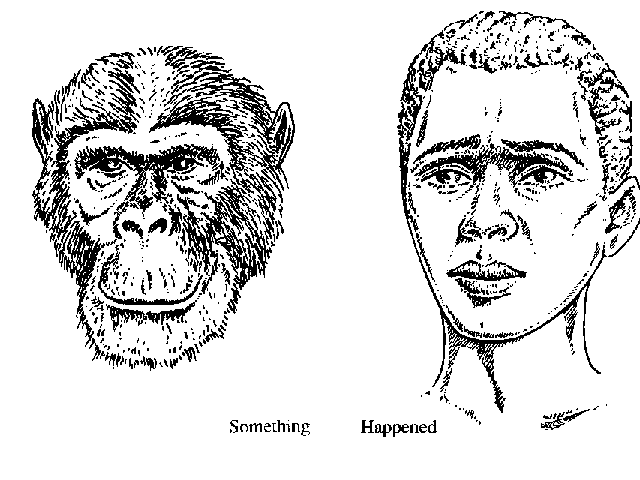
Humans are classed anatomically among the primates, the order of which includes apes, monkeys and lemurs. Among the hundreds of living primate species, only humans are naked.
Two kinds of habitat are known to give rise to naked mammals - a subterranean one or a wet one. There is a naked Somalian mole rat which never ventures above ground. All other non-human mammals which have lost all or most of their fur are either swimmers like whales and dolphins and walruses and manatees, or wallowers like hippopotamuses and pigs and tapirs. The rhinoceros and the elephant, though found on land since Africa became drier, bear traces of a more watery past and seize every opportunity of wallowing in mud or water.
It has been suggested that humans became hairless "to prevent overheating in the savannah". But no other mammal has ever resorted to this strategy. A covering of hair acts as a defense against the heat of the sun: that is why even the desert- dwelling camel retains its fur. Another version is "to facilitate sweat-cooling". But again many species resort to sweat-cooling quite effectively without needing to lose their hair.
There is no known reason why an ape should suffer more from overheating than the savannah baboon. And, especially for a savannah primate, there would be a high price to pay for hairlessness. Primate infants are carried around clinging to their mothers' fur; the females would be severely hampered in their foraging when that no longer became possible.
One general conclusion seems undeniable from an overall survey of mammalian species: that while a coat of fur provides the best insulation for land mammals the best insulation in water is not fur, but a layer of fat.
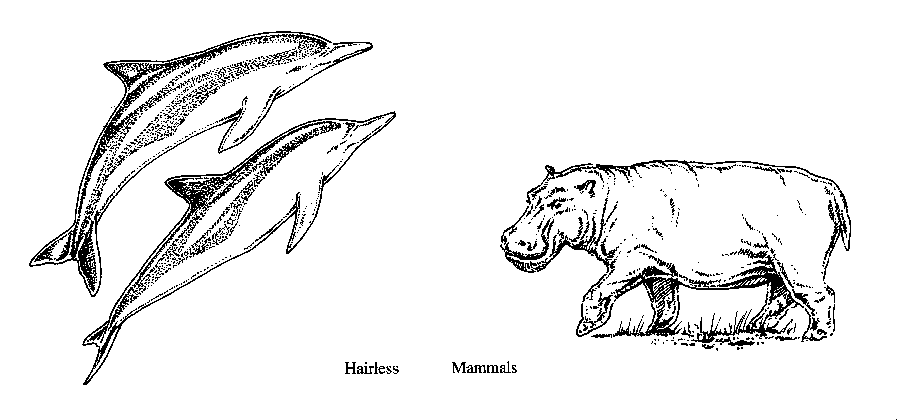
Humans are by far the fattest primates; we have ten times as many fat cells in our bodies as would be expected in an animal of our size.
There are two kinds of animals which tend to acquire large deposits of fat - hibernating ones and aquatic ones. In hibernating mammals the fat is seasonal; in most aquatic ones, as in humans it is present all the year round. Also, in land mammals fat tends to be stored internally, especially around the kidneys and intestines; in aquatic mammals and in humans a higher proportion is deposited under the skin.
It is unlikely that early man would have evolved this feature after moving to the plains and becoming a hunter, because it would have slowed him down. No land-based predator can afford to get fat. Our tendency to put on fat is likelier to be an inheritance from an earlier aquatic phase of our evolution. It is true that some apes, especially in captivity, may put on weight, but we still differ from them in two important ways. One is that they are never born fat. All infant primates except our own are slender; their lives may depend on their ability to cling to their mothers and support their whole weight with their fingers. Our own babies accumulate fat even before birth and continue to grow fatter for several months afterwards. Some of this fat is white fat, and that is extremely rare in new-born mammals. White fat is not much good for supplying instant heat and energy. It is good for insulation in water, and for giving buoyancy.
The other difference is that in our case the subcutaneous fat is bonded to the skin. When an anatomist skins a cat or rabbit or chimpanzee, any superficial fat deposits remain attached to the underlying tissues. In the case of humans, the fat comes away with the skin, just as it does in aquatic species like dolphins, seals, hippos and manatees.
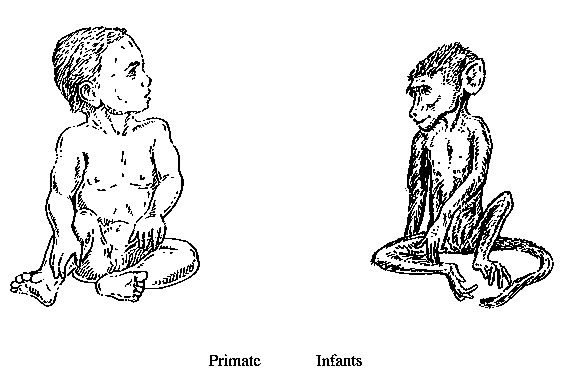
Human beings are the only mammals in the world that habitually walk on two legs. (The only other creature with a perpendicular gait is an aquatic bird, the penguin.)
It is not surprising bipedalism is so rare. Compared with running or walking on four legs it has many disadvantages. It is slower; it is relatively unstable; it is a skill that takes many years to learn, and it exposes vulnerable organs to attack.
We have been doing it for five million years and in that time our bodies have been drastically remoulded to make it easier, but it is still the direct cause of many discomforts and ailments such as back pains, varicose veins, haemorrhoids, hernias and problems in childbirth. It would have been far more difficult and laborious for our ape-like ancestors; only some powerful pressure could have induced them to adopt a way of walking for which they were initially so ill suited.
One hypothesis used to be that they first developed big brains and began to make tools, and finally walked on their hind legs to free their hands for carrying weapons. But we now know that it was bipedalism that came first, before the big brain and tool-making.
However, if their habitat had become flooded, they would have been forced to walk on their hind legs whenever they came down to the ground in order to keep their heads above water. The only animal which has ever evolved a pelvis like ours, suitable for bipedalism, was the long-extinct _Oreopithecus_, known as the swamp ape.
Today, two primates when on the ground stand and walk erect somewhat more readily than most other species. One, the proboscis monkey, lives in the mangrove swamps of Borneo. The other is the bonobo or pygmy chimpanzee; its habitat includes a large tract of seasonally flooded forest, which would have covered an even more extensive area before the African climate became drier.
Both of these species enjoy the water. It is interesting that the bonobos often mate face-to-face as humans do; in our case it is explained as a consequence of bipedalism. This mode of mating is another characteristic very rare among land animals, which we share with a wide range of aquatic mammals such as dolphins, beavers and sea otters. What we have in common with them is a mode of locomotion in which the spine and the hind limbs are in a straight line, and that affects the position of the sex organs.
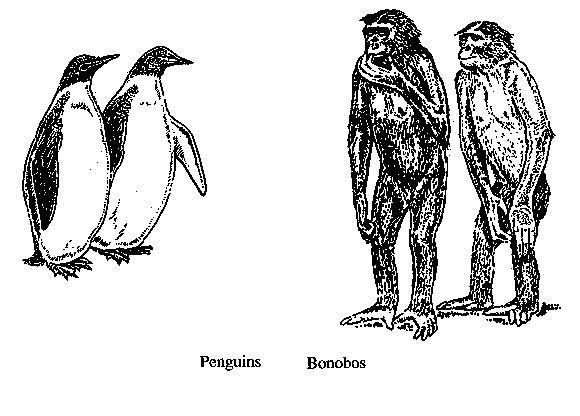
The human respiratory system is unlike any other land mammal's in two respects.
The first is that we have conscious control of our breathing. In most mammals these actions are involuntary, like the heart beat or the processes of digestion.
Voluntary breath control appears to be an aquatic adaptation because, apart from ourselves, it is found only in aquatic mammals like seals and dolphins. When they decide how deep they are going to dive, they can estimate how much air they need to inhale. Without voluntary breath control it is very unlikely that we could have learned to speak.
The other human peculiarity is called "the descended larynx". A land mammal is normally obliged to breathe through its nose most of the time, because its windpipe passes up through the back of the throat and the top end of it (the larynx) is situated in the back of its nasal passages. A dog, for example, has to make a special effort to bring its larynx down into its throat in order to bark or to pant; when it relaxes, the larynx goes back up again. Even our own babies are born like that.
A few months after birth the human larynx descends into the throat, right down below the back of the tongue. Darwin found that very puzzling because it means that the opening to the lungs lies side by side with the opening to the stomach. That is why in our species food and drink may sometimes go "down the wrong way". If we had not evolved an elaborate swallowing mechanism it would happen every time.
This arrangement means that we can breathe through our mouths as easily as through our noses. It is probable that this is an aquatic adaptation, because a swimmer needing to gulp air quickly can inhale more of it through the mouth than through the nostrils. And we do know that the only birds which are obligatory mouth breathers are diving birds like penguins, pelicans and gannets. As for mammals, the only ones with a descended larynx, apart from ourselves, are aquatic ones - the sea lion and the dugong.
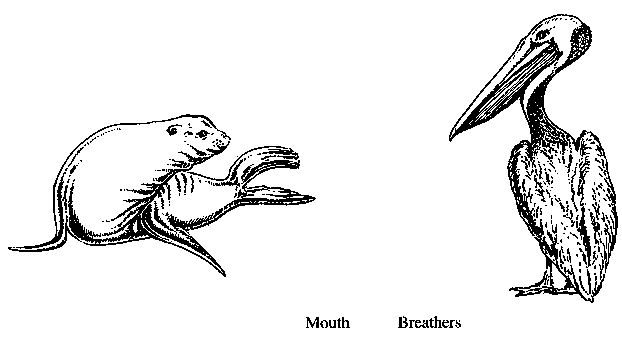
It is impossible in a brief outline to discuss all the physical features distinguishing us from the apes, but a few are worth mentioning.
For example, we have a different way of sweating from other mammals, using different skin glands. It is very wasteful of the body's essential resources of water and salt. It is therefore unlikely that we acquired it on the savannah, where water and salt are both in short supply.
We weep tears of emotion, controlled by different nerves from the ones that cause our eyes to water in response to smoke or dust. No other land animal does this. There are marine birds, marine reptiles and marine mammals which shed water through their eyes, or through special nasal glands, when they have swallowed too much seawater. This process may also be triggered in them by an emotional excitement caused by feeding or fighting or frustration. Weeping animals, apart from ourselves, include the walrus, the seal and the sea otter.
We have millions of sebaceous glands which exude oil over head, face and torso, and in young adults often causes acne. The chimpanzee's sebaceous glands are described as "vestigial" whereas ours are described as "enormous". Their purpose is obscure. In other animals the only known function of sebum is that of waterproofing the skin or the fur.
The most widely discussed contrast between ourselves and the apes is that we have bigger brains. A bigger brain may well have been an advantage to early man, but it would have been equally of advantage to a chimpanzee: the question is why one of them acquired it.
One factor may have been nutritional. The building of brain tissue, unlike other body tissues, is dependent on an adequate supply of Omega-3 fatty acids, which are abundant in the marine food chain but relatively scarce in the land food chain.
AAT is the only theory which logically connects all these and other enigmatic features and relates them to a single well attested historical event.
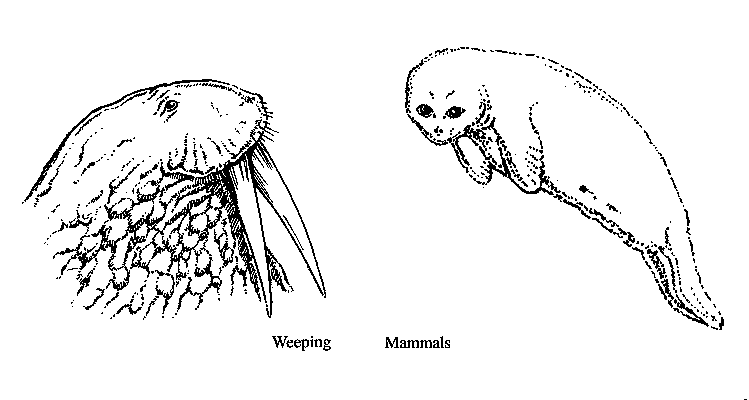
It is now generally agreed that the man/ape split occurred in Africa between 7 and 5 million years ago, during a period known as the fossil gap.
Before it there was an animal which was the common ancestor of human and African apes. After it, there emerged a creature smaller than ourselves, but bearing the unmistakable hallmark of the first shift towards human status: it walked on two legs.
This poses two questions: "Where were the earliest fossils found?" and "Do we know of anything happening in that place at that time that might have caused apes and humans to evolve along separate lines?"
The oldest pre-human fossils (including the best known one, "Lucy") are called Australopithecus Afarensis because their bones were discovered in the Afar triangle, an area of low lying land near the Red Sea. About 7 million years ago that area was flooded by the sea and became the Sea of Afar.
Part of the ape population living there at the time would have found themselves living in a radically changed habitat. Some may have been marooned on off-shore islands - the present day Danakil Alps were once surrounded by water. Others may have lived in flooded forests, salt marshes, mangrove swamps, lagoons or on the shores of the new sea, and they would all have had to adapt or die.
AAT suggests that some of them survived, and began to adapt to their watery environment. Much later, when the Sea of Afar became landlocked and finally evaporated, their descendants returned to the mainland of Africa and began to migrate southwards, following the waterways of the Rift Valley upstream.
There is nothing in the fossil record to invalidate this scenario, and much to sustain it. Lucy's bones were found at Afar lying among crocodile and turtle eggs and crab claws at the edge of a flood plain near what would then have been the coast of Africa.
Other fossils of Australopithecus, dated later, were found further south, almost invariably in the immediate vicinity of ancient lakes and rivers.
We now know that the change from the ape into Australopithecus took place in a short space of time, by evolutionary standards. Such rapid speciation is almost invariably a sign that one population of a species has become isolated by a geographical barrier such as a stretch of water.
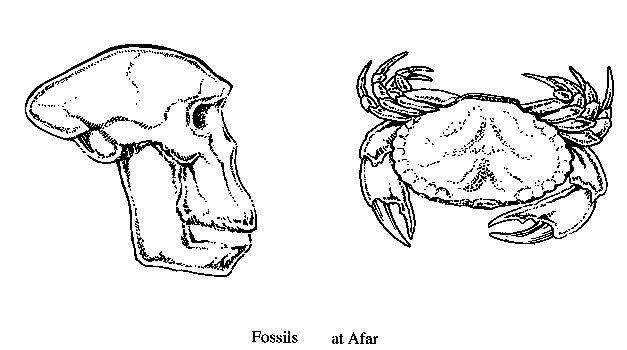
| CHARACTERISTICS | HUMANS | APES | SAVANNAH | AQUATICS |
|---|---|---|---|---|
| Habitual bipedalism | Yes | - | - | - |
| Loss of body hair | Yes | - | Yes (rhino and elephant) | Yes |
| Skin-bonded fat deposits | Yes | - | - | Yes |
| Ventro-ventral copulation | Yes | Yes (bonobo) | - | Yes |
| Diminution of apocrine glands | Yes | - | - | Yes |
| Hymen | Yes | - | - | Yes |
| Enlarged sebaceous glands | Yes | - | - | Yes |
| Psychic tears | Yes | - | - | Yes |
| Loss of vibrissae | Yes | - | - | Yes |
| Volitional breath control | Yes | - | - | Yes |
| Eccrine thermoregulation | Yes | - | - | Yes |
| Descended larynx | Yes | - | - | Yes |
| The aquatic phase took place more than 5 million years ago. Since then, Homo has had 5 million years to re-adapt to terrestrial life. It is not surprising that the traces of aquatic adaptation have become partially obliterated and have gone unrecognised for so long. But the traces are still there as the table indicates. | ||||

Academics wishing to read detailed arguments on both sides will find the views of 22 contributors presented in: 'The Aquatic Ape: Fact or Fiction?', Souvenir Press, 1991, [UK Pounds] 20.00.
Some reactions to 'The Scars of Evolution'.
"This is an exceptionally well written book, which is not surprising given that Elaine Morgan is a notable dramatist; but what is surprising is that it is such a good piece of science. I lent my copy to a distinguished zoologist and Fellow of the Royal Society. Somewhat to his surprise it proved to be an excellent monograph which betrayed no sign of amateurism. He also found it highly enjoyable.
"Elaine Morgan seems to have succeeded where the professionals
have failed. She has made a genuine contribution to evolutionary
theory which synthesizes research from a wide range of
scientific disciplines; and she has presented it in a form which
is accessible to the interested lay reader."
- 'British Medical Journal'.
"The 'aquatic ape' hypothesis has come of age.... [Elaine Morgan]
provides a wealth of meticulously researched findings, detailed hypotheses and still controversial solutions in areas where
others have volunteerednothing at all. The cost of conceding to
Morgan would be a palaeontological crisis as profound as that of
the earth scientists when adjusting to the equally "impossible"
idea of floating continents."
- 'Journal of the Royal Anthropological Institute'
"A powerfully argued and well supported thesis."
- Prof. Roger W. Wescott, Dept. of Anthropology, Drew Univ., USA
"'The Scars of Evolution' is based on logical thinking, sharp
observation and a thorough knowledge of the literature. It is a
valuable source of information for anyone interested in human
biology and evolution. At the same time it is most enjoyable to
read."
- Dr. H. Tuomisto, Dept. of Biology, Univ. of Turku, Finland.